Power Pitch
fMRI: Rethink Everything
ISMRM & ISMRT Annual Meeting & Exhibition • 10-15 May 2025 • Honolulu, Hawai'i

| 13:45 |
 |
Screen Number: 1
0195. Cerebrovascular
reactivity mapping without gas inhalation: signal
characterization with multi-echo BOLD
O. Akinwale, Z. Hu, E. Yacoub, P. Liu, H. Lu
Johns Hopkins University School of Medicine, Baltimore, United States
Impact: Breath-modulation resulted in an EtCO2 reduction
by ~2.5mmHg. In terms of the BOLD acquisition sequences,
ME-BOLD T2* CVR yielded a similar precision as the SG-BOLD,
but with higher accuracy. Breath-modulation MRI can also
yield reliable bolus arrival time maps.
|
| 13:47 |
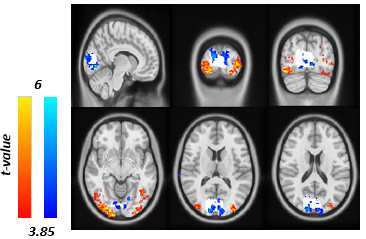 |
Screen Number: 2
0196. Metabolic
response in deactivated areas using fMRS at 3T
L. Cairone, M. Guidi, A. Napolitano, S. Mangia, F. Giove
'La Sapienza' University of Rome, Rome, Italy
Impact: Neurometabolic profiling during deactivation can
help elucidating the neural origin of NBR, offering
information about brain metabolic diseases through
assessment of dissociation between neurovascular and
neurometabolic coupling. Lactate and glutamate decreases are
coherent with reduced excitation within the deactivated
area.
|
| 13:49 |
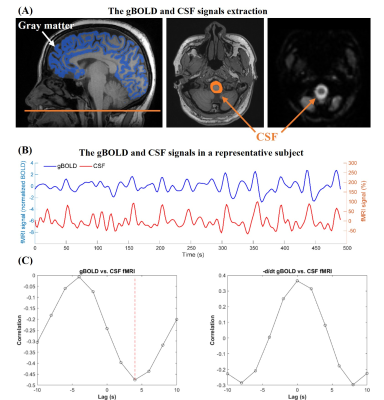 |
Screen Number: 3
0197. Decoupling
of Global Brain Activity and Cerebrospinal Fluid Dynamics in
Obstructive Sleep Apnea: Links to Disease Severity and Hypoxemia
Z. Xiong, Y. Yang, Y. Zhou, Z. Wang, J. He, L. Nie, R. Wang,
X. Zeng
Guizhou Provincial People’s Hospital, Guiyang, China
Impact: This study reveals how OSA disrupts brain-CSF
interactions and suggests that gBOLD-CSF coupling may serve
as a biomarker for diagnosis and treatment. Future research
should explore whether improving oxygenation or sleep
quality can restore coupling and enhance cognitive function.
|
| 13:51 |
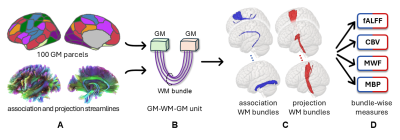 |
Screen Number: 4
0198. Myelination
selectively modulates BOLD signal characteristics in white
matter: from myelin content to gene expression
Y. Gao, L. Xu, K. Schilling, S. Choi, R. Chen, Y. Li, M. Li,
Z. Zu, Z. Ding, A. Anderson, J. Gore
Vanderbilt University, Nashville, United States
Impact: This study demonstrates a heterogeneous
dependence of white matter functional signals on myelin,
supported by both in-vivo MRI evidence and gene expression
data, while confirming a strong effect of vascular density
on BOLD effects
|
| 13:53 |
Screen Number: 5
0199. WITHDRAWN |
|
| 13:55 |
 |
Screen Number: 6
0200. Repeated
functional magnetic resonance imaging of the lumbosacral cord
during electrical stimulation of the tibial nerve
C. Kündig, S. Büeler, M. Liechti, T. Kessler, P. Freund, G.
David
Balgrist University Hospital, University of Zurich , Zurich, Switzerland
Impact: BOLD fMRI of the lumbosacral cord during
transcutaneous electrical tibial nerve stimulation is
feasible, and the required scan times of 24 minutes are
clinically achievable. The differences between sessions
suggest an impact of habituation, warranting further
investigation.
|
| 13:57 |
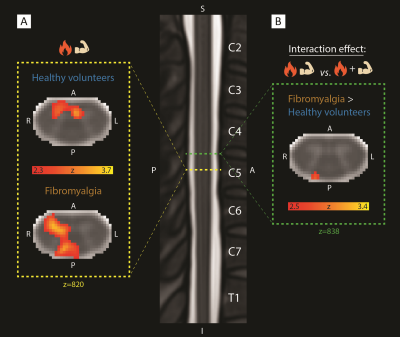 |
Screen Number: 7
0201. Neural
correlates of aberrant pain processing and modulation in
fibromyalgia: a simultaneous spinal cord-brain fMRI study
D. Pfyffer, M. Kaptan, C. Law, K. Weber II, V. Oliva, S.
Bédard, T. Indriolo, T. Maronesy, G. Glover, S. Mackey
Stanford University School of Medicine, Palo Alto, United States
Impact: Identification of dysfunctional networks
involved in pain modulation along the neuroaxis might
present promising neural targets for more efficient
treatment of chronic pain (e.g., non-invasive brain or
spinal cord stimulation) and advance the development of pain
biomarkers and precision medicine.
|
| 13:59 |
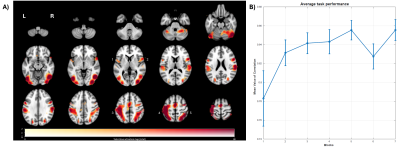 |
Screen Number: 8
0202. Investigation
of sustained blood flow and metabolic changes in the healthy
brain following motor learning
D. Di Censo, S. Censi, F. Graziano, E. Patitucci, M.
Carriero, S. Pomante, F. Procida, F. Tomaiuolo, M. G. Tullo,
M. Germuska, E. Biondetti, A. Caporale, A. Chiarelli, V.
Tomassini, R. Wise
University 'G. D'annunzio' of Chieti-Pescara, Chieti, Italy
Impact: These results provide a framework for
investigating learning-related brain blood flow and
metabolic changes that may sustain long-term plasticity
relevant for mitigating neurological conditions.
|
| 14:01 |
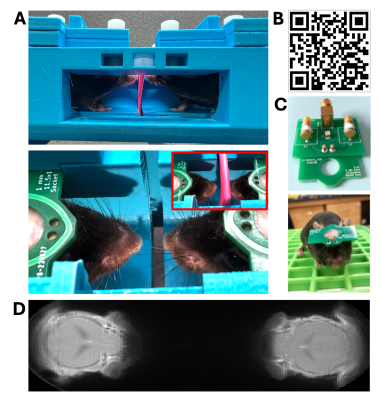 |
Screen Number: 9
0203. Mapping
inter-brain synchrony in awake, socially interacting mice using
SORDINO hyperscanning
T-H Chao, S. Song, M. MacKinnon, S-H Lee, L-M Hsu, R.
Nonneman, Y-Y Shih
The University of North Carolina at Chapel Hill, Chapel Hill, United States
Impact: We demonstrated a robust large-scale inter-brain
synchronization in socially interacting mice using a novel,
silent, motion-insensitive SORDINO-fMRI hyperscanning
method, enabling future exploration of neural circuit- and
network-level mechanisms behind inter-brain synchronization
that are challenging to investigate with conventional
approaches.
|
| 14:03 |
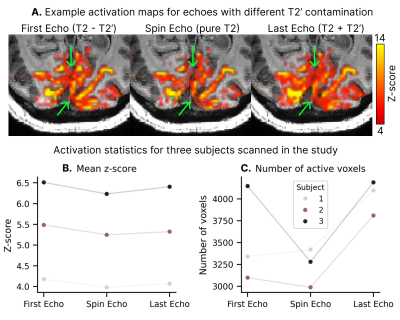 |
Screen Number: 10
0204. Resolving
T2 and T2' contributions to BOLD response speed and nonlinearity
using 7T EPTI
D. Gomez, B. Ashenegar, Z. Hu, H. Fisher, Z. Dong, F. Wang,
J. Polimeni, L. Lewis
Massachusetts General Hospital, Charlestown, United States
Impact: We tested whether pure-T2 signals BOLD can
enable more specific BOLD responses by simultaneously
measuring pure-T2 and T2’ contributions using spin-echo
echo-planar time-resolved imaging. Pure-T2 weighting
decreased the non-linearity of BOLD responses and reduced
response time-to-peak by hundreds of milliseconds.
|
| 14:05 |
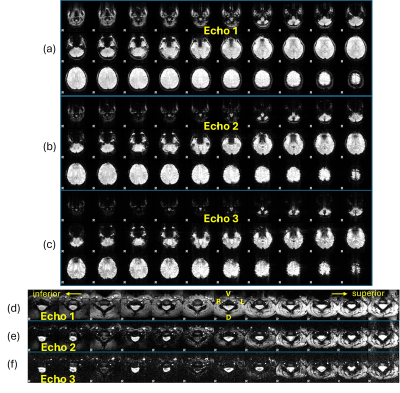 |
Screen Number: 11
0205. Multiecho
Cardiac-Gated fMRI Enhances Activation Detection in Simultaneous
Brain-Spinal Cord Imaging
C. Law, M. Kaptan, D. Pfyffer, Y. Wang, K. Weber II, S.
Mackey, G. Glover
Stanford University, Stanford, United States
Impact: This study demonstrates that multiecho
cardiac-gated fMRI enhances spinal cord activation
detection, enabling more precise brain-spinal cord
connectivity mapping. This advancement could refine clinical
assessments of pain and motor disorders, driving further
exploration of physiological noise reduction techniques in
neuroimaging.
|
| 14:07 |
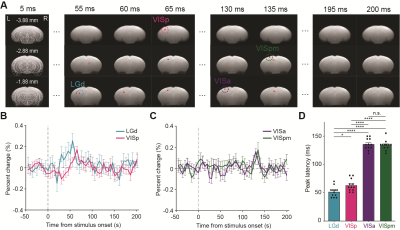 |
Screen Number: 12
0206. In
vivo Detection of Mouse Visual Sensory Pathways using
Multi-Slice DIANA fMRI
J-Y Keum, P. T. Toi, J. Park, J-Y Park
Sungkyunkwan University, Suwon, Korea, Republic of
Impact: The implementation of multi-slice DIANA fMRI
with millisecond temporal resolution is expected to enhance
our understanding of mouse visual pathways, revealing new
insights into brain circuitry and supporting the development
of dynamic brain network models.
|
| 14:09 |
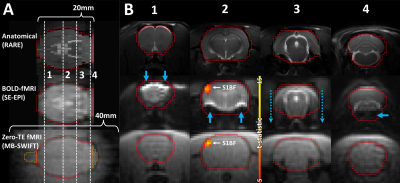 |
Screen Number: 13
0207. Zero
echo time fMRI enables artifact-free whole-brain functional
imaging at 16.4T
J. Valjakka, S. Ponticorvo, L. Wu, D. Koski, R. Salo, D.
Idiyatullin, J. Paasonen, O. Gröhn, S. Michaeli, S. Mangia
University of Eastern Finland, Kuopio, Finland
Impact: This work demonstrates that zero echo time fMRI
can overcome the limitations that T2/T2*-weighted EPI faces
at ultra-high field, having the potential to facilitate the
advancement of ultra-high field whole-brain functional
imaging.
|
| 14:11 |
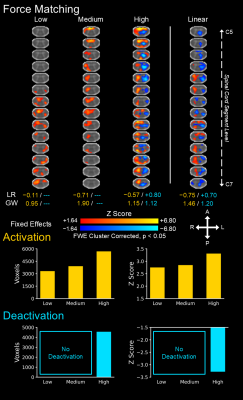 |
Screen Number: 14
0208. Mapping
Hand Function in the Brain and Spinal Cord with Simultaneous
Brain-Spinal Cord Functional MRI
V. Oliva, S. Bédard, A. Smith, M. Kaptan, D. Pfyffer, B.
Chy, S. Aufrichtig, N. Berhe, J. Ratliff, S. Hu, Z. Smith,
T. Hastie, S. Delp, S. Mackey, G. Glover, A. Chaudhari, C.
Law, K. Weber II
Italian National Institute of Health, Rome, Italy
Impact: We mapped brain and SC neural correlates of hand
function showing activations and deactivations in sensory
and motor regions, providing a more complete picture of
motor control.
|
| 14:13 |
 |
Screen Number: 15
0209. Zero
echo time MB-SWIFT fMRI in rat spinal cord during hind paw
stimulation - correlation with electrical activity
P. Stenroos, I. Gureviciene, H. Laakso, R. Salo, E.
Paasonen, J. Paasonen, S. Michaeli, S. Mangia, H. Tanila, O.
Gröhn
A.I. Virtanen Institute, Kuopio, Finland
Impact: MB-SWIFT fMRI provides a valuable experimental
tool for assessing stimulation evoked response in the spinal
cord, validated here to have good agreement with electrical
activity.
|
| 14:15 |
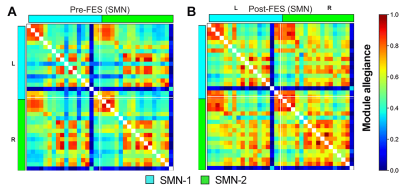 |
Screen Number: 16
0210. Early
Cortical Reorganization in the Sensorimotor Network Following
FES Cycling Intervention in Individuals with Chronic SCI.
L. Ismaila, C. Sadowsky, A. Choe
Johns Hopkins University School of Medicine, Baltimore, United States
Impact: Our findings reveal FES-induced reorganization
within the sensorimotor network of the SCI group at the
post-FES stage. This could guide clinicians, researchers,
and rehabilitation specialists in using rs-fMRI to observe
early cortical changes, even when measurable motor
improvements are absent.
|
| 14:17 |
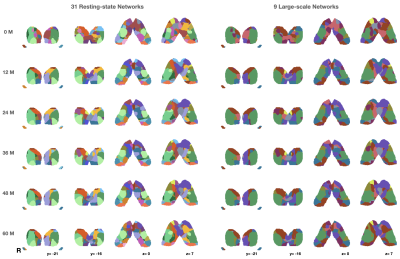 |
Screen Number: 17
0211. Emerging
Patterns of Thalamocortical Connectivity in Early Brain
Development
W. Lyu, K-H Thung, K. Huynh, S. Ahmad, P-T Yap
University of North Carolina at Chapel Hill, CHAPEL HILL, United States
Impact: We present the first map of thalamocortical
connectivity across early childhood, showing its dynamic
changes over this period. Our findings suggest a
developmental gradient in thalamic function, traversing from
posterior to anterior and from lateral to medial regions.
|
| 14:19 |
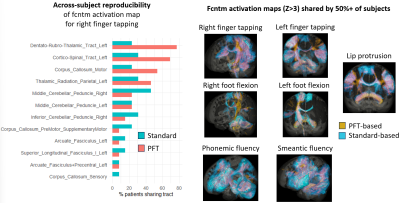 |
Screen Number: 18
0212. Individualized
Functionnectome for the detection of white matter circuits
underlying task-fMRI activations in glioma patients

G. Sighinolfi, A. De Luca, D. N. Manners, R. Lodi, C.
Tonon, A. Leemans
IRCCS Istituto delle Scienze Neurologiche di Bologna, Bologna, Italy
Impact: The individualized Functionnectome framework
applies the precision medicine paradigm to radiomics, by
using brain connectivity maps conformant to each patient’s
unique anatomy, thereby ensuring accurate projection in
cases with disrupted structures, e.g., due to tumors.
|
| 14:21 |
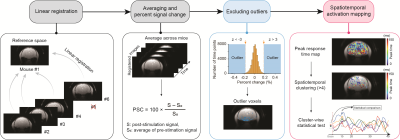 |
Screen Number: 19
0213. Spatiotemporal
Activation Mapping for Enhanced Neural Activity Detection in
Direct Imaging of Neuronal Activity (DIANA) fMRI

J-Y Keum, P. T. Toi, S. Park, H. Chun, J-Y Park
Sungkyunkwan University, Suwon, Korea, Republic of
Impact: Spatiotemporal activation mapping is expected to
enhance our understanding of sensory information processing
across the brain, by enabling DIANA fMRI to detect specific
brain activation areas, ultimately contributing to realistic
modeling of dynamic brain networks at the neural circuit
level.
|
| 14:23 |
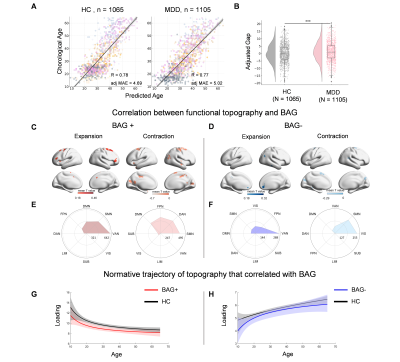 |
Screen Number: 20
0214. Heterogeneous
lifespan development of functional networks in major depression
and its association with clinical and gene expression profiles

C. Pang, X. Sun, X. Wang, D. Wei, Y. Chen, B. Liu, C-C
Huang, Y. Zheng, Y. Wu, T. Chen, Y. Cheng, X. Xu, Q.
Gong, T. Si, S. Qiu, C-P Lin, J. Cheng, Y. Tang, F.
Wang, J. Qiu, P. Xie, L. Li, Y. He, M. Xia
Beijing Normal University, Beijing, China
Impact:
Our results highlight the heterogeneity of neurodevelopment in depression and suggest potential underlying molecular mechanisms, providing deeper insights into the disorder’s progression and supporting the identification of biomarkers for precise diagnosis and treatment. |
| 14:25 |
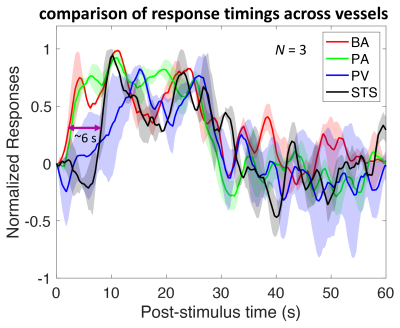 |
Screen Number: 21
0215. Progression
of visual-stimulus-evoked blood velocity response timing across
individual arteries and veins measured with phase-contrast fMRA
Z. Hu, S. Proulx, D. Varadarajan, D. Gomez, S. Bollmann, J.
Polimeni
Massachusetts General Hospital, Charlestown, United States
Impact: We measured neuronal activity-induced blood
velocity responses across several stages of the
macrovasculature. The mismatches in arterial and venous
hemodynamic response timing can provide insight into
tissue/microvascular hemodynamics, such as microvascular
blood volume changes with activation.
|
| 14:27 |
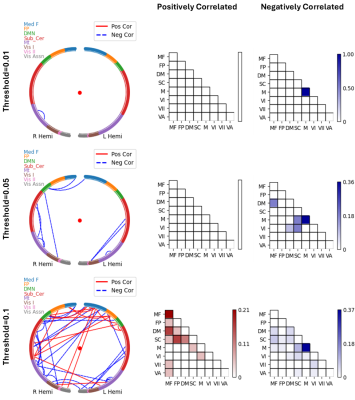 |
Screen Number: 22
0216. Linking
Brain Functional Connectivity of Older Adults to Maximum
Voluntary Contraction: Towards a Neural Marker of Motor Strength
A. Ghaffari, V. Masjedizadeh, X. Chen, J. Langley, A. Seitz,
M. Peters, W. Zhang, I. Bennett, X. Hu
University of California, Riverside, Riverside, United States
Impact:
Older adults tend to experience impaired motor functions due to aging or certain diseases. Here, we determined the most crucial functional connections assessing the motor abilities of older adults which could be used as the targets for their rehabilitation programs. |
| 14:29 |
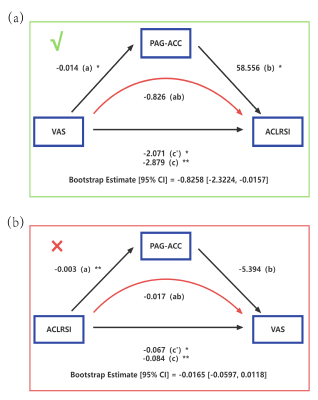 |
Screen Number: 23
0217. The
Role of Neuroplasticity in Pain and Fear of Re-Injury Following
ACL Reconstruction
Y. Zhang, G. Yang, X. Zeng, S. Pan, C. Li, C. Qian, H. Wang
Fudan University, Shanghai, China
Impact: The study reveals that peripheral nociceptive
input alters brain structure and function in ACLR patients,
emphasizing the critical need for targeted
neuropsychological interventions alongside comprehensive
physical rehabilitation to improve pain management and
return-to-sport success.
|
| 14:31 |
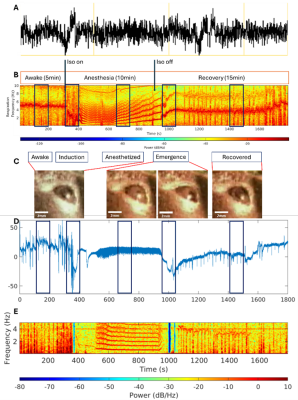 |
Screen Number: 24
0218. State-transition
fMRI between anesthetized and awake mice

D. Hike, X. Liu, X. Zhou, A. Smith, N. Pasupathy, C.
Lin, Y. Jiang, A. Devor, X. Yu
Athinoula A. Martinos Center for Biomedical Imaging, Department of Radiology, Massachusetts General Hospital, Boston, United States
Impact: Distinct brain regions along reticular ascending
pathways can be directly identified by analyzing the
spectral-specific rs-fMRI signal changes that occur as
animals transition into and out of anesthetized states. This
work opens a new avenue for consciousness studies in
rodents.
|
| 14:33 |
 |
Screen Number: 25
0219. Resting-State
Functional Electrical Properties Tomography (rsfEPT)
J. Luo, K. Shmueli
University College London, London, United Kingdom
Impact: We demonstrated rsfEPT for the first time using
ICA. In addition to elucidating potential contributions to
task-based fEPT, both neurophysiological and noisy or
artifactual, this rsfEPT technique opens the possibility to
reveal new conductivity-based resting-state networks in the
human brain.
|
The International Society for Magnetic Resonance in Medicine is accredited by the Accreditation Council for Continuing Medical Education to provide continuing medical education for physicians.